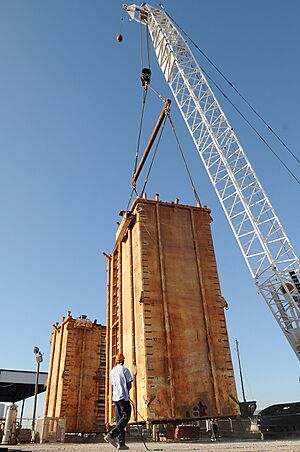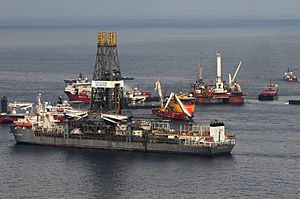Efforts to stem the Deepwater Horizon oil spill facts for kids
When the Deepwater Horizon oil rig exploded on April 20, 2010, a huge oil spill began in the Gulf of Mexico. Efforts to stop this spill started right away and continued until the well was finally sealed on July 15, 2010. This disaster sadly killed many animals, including 61 dolphins and other mammals, over 2,000 birds, and nearly 500 endangered sea turtles. The Deepwater Horizon spill released more oil than the 1989 Exxon Valdez spill, making it the largest oil spill in U.S. waters.
Much of the oil sank deep into the Gulf. Scientists believe that tiny living things called microbes will eventually clean up this oil naturally. This process is called bioremediation. Experts like Terry Hazen from the Department of Energy said this could take months or even years. He noted that microbes work faster in warmer water. Some large oil-skimming ships, like A Whale, couldn't do much because BP used special chemicals called dispersants. Some experts, like Robert Bea, felt that older methods of cleaning oil were better. He believed dispersants didn't truly help the environment, even if they kept beaches clean.
Contents
How They Tried to Stop the Oil Leak
Early Attempts to Stop the Flow
The first tries to stop the oil involved using robots underwater. They tried to close the valves on the well, but this didn't work. Next, engineers tried placing a giant, heavy dome, weighing about 125 tons, over the biggest leak. The idea was to collect the oil and send it to a ship on the surface. However, this also failed. Cold water mixed with gas from the leak, forming icy crystals that blocked the dome's opening.
On May 14, engineers tried a different method. They put a 6-inch wide tube into the broken 21-inch wide pipe. This tube had a stopper to direct the oil flow into it. The collected gas was burned off, and the oil was stored on a ship called the Discoverer Enterprise. This method collected about 924,000 gallons of oil before the tube was removed.
On May 26, BP tried a method called "top kill". This involved pumping heavy drilling mud into the well to stop the oil flow. After the mud, they planned to seal it with cement. Unfortunately, the "top kill" also failed.
After the "top kill" failed, BP tried a new plan on May 29. They removed the damaged pipe from the top of the well and placed a cap over it. This cap connected to another pipe that would carry the oil away. The cap was attached on June 3, and it started collecting the leaking oil. BP's CEO, Tony Hayward, said they were capturing "the vast majority of the oil." However, some experts believed that even more oil was escaping than before.
On June 16, a second system started working. It connected directly to the well and sent oil and gas to a service ship called the Q4000. This ship could process about 5,000 barrels of oil each day. Both the oil and gas were burned safely on the Q4000.
More ships were brought in to help. The Discoverer Clear Leader and the Helix Producer 1 helped collect oil, which was then moved to large tankers. By July 5, BP reported collecting about 24,980 barrels of oil in one day. They also burned off a lot of natural gas. By late June, the government estimated that the cap and other equipment were capturing less than half of the oil leaking from the seafloor.
On July 10, robots removed the cap to put a better-fitting one in place. This meant oil flowed freely into the Gulf until the new cap was installed. A broken pipe was replaced on July 11, and the new cap was put on top.
Stopping the Leak Temporarily
On July 15, 2010, BP announced that they had successfully stopped the oil leak using a tightly fitted cap. This cap weighed 75 tons and stood 30 feet tall. It was bolted to the broken blowout preventer. This cap was a temporary fix.
President Barack Obama was happy about the news but warned that it was important not to get too excited yet. If the cap held for 48 hours, its valves would be opened briefly for tests. These tests would make sure oil wasn't escaping into the rocks below the seafloor. When the leak was stopped, oil had been flowing into the Gulf of Mexico for 85 days, 16 hours, and 25 minutes since the Deepwater Horizon rig exploded on April 20, 2010.
For a few days, there was no sign that the well was leaking again, which meant the cap seemed to be working. Admiral Thad Allen, who was in charge of the operation, said the cap would be used to send oil to surface ships for collection. It would also help shut down the well during bad weather. The goal was to permanently seal the well by mid-August 2010, once special "relief wells" were finished. However, on July 19, some oil was seen seeping from the seafloor near the well. Admiral Allen thought this was probably natural, as oil and gas sometimes seep from cracks in the Gulf floor.
On July 22, Admiral Allen faced a tough choice. A storm, Tropical Storm Bonnie, was headed their way, meaning support ships had to leave the site. The capping stack would be left alone for days. The safe choice would have been to open the valves to release pressure, but this would let the oil gush out again. Admiral Allen, after talking with Energy Secretary Steven Chu, decided to keep the valves closed. A BP vice president, Kent Wells, said they were confident enough to leave the well shut. Since the storm was weaker than expected, ships returned on July 24 to finish the job.
Permanently Sealing the Well
To permanently stop the leak, BP drilled two "relief wells" into the original well. Once these new wells reached the old one, they would pump heavy drilling mud into it. One relief well, drilled by the Development Driller III, started on May 2. Another, drilled by the GSF Development Driller II, started on May 16. These relief wells began working in August 2010. Each well cost about $100 million.
Despite delays from Tropical Storm Bonnie, the first part of the permanent sealing was planned for July 30. Admiral Thad Allen announced on July 26 that a "static kill" could start on August 2. This involved pouring mud and cement into the top of the well. A "bottom kill" would follow, where mud and cement would enter the well from under the seafloor, possibly by August 7.
On August 3, at 3:00 PM CDT, they started pumping drilling mud into the well. Pumping continued for eight hours, and the well was then declared "static," meaning the flow had stopped.
On August 4, at 9:15 AM CDT, with Admiral Allen's approval, BP began pumping cement from the top. This permanently sealed that part of the well. Admiral Allen confirmed the "static kill" was working. However, two weeks later, he said it was still unclear when the well would be fully sealed. The "bottom kill" had not happened yet, and the relief well was delayed by storms.
On September 10, Admiral Allen said the "bottom kill" could start sooner than expected. BP said the relief well was about 50 feet from its target. On September 16, the relief well reached its destination, and cement was pumped in to seal the well. Officials announced on September 18 that the cement had completed the sealing. Finally, on September 19, after pressure tests, Admiral Allen declared the well "officially dead."
Considering Explosives
In May 2010, Energy Secretary Steven Chu gathered a team of scientists, including experts in nuclear weapons. On May 24, BP decided against using regular explosives. They said that if explosions failed to clog the well, they would lose all other options.
Government officials also ruled out using nuclear devices. This was because of environmental risks and international agreements. Admiral Thad Allen explained that using explosives could damage the well even more. It might create new cracks, allowing oil to seep uncontrollably through the seafloor. He felt this risk was too great.
Images for kids




